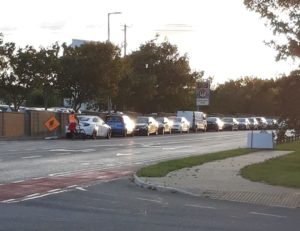Submission from Wexford Bicycle User Group (WexBUG)

www.WexBUG.org
Twitter @WexBug
| WexBUG is a bicycle user group made up of Wexford residents who are trying to drive change from car centred thinking to active travel and cycling in Wexford. We want provision for cycling and active travel. Not just lines painted on the road. We want grannies and kids and ‘non-cyclists’ to feel that cycling is a safe and valid transport choice. We want to give our children something of the childhood we had: cycling to school, to the beach, some independence, healthy active choices. We want to give parents and our elderly community the chance to enjoy our beautiful towns and villages without fear and without being forced to use a car. It is expected that this is the first generation that will live a shorter life than their forebears. We don’t want this to be the legacy we leave our children! |
Submission to Wexford County Council on its Age Friendly Strategy (October 2021)
| Summary:A core part of WexBUG membership consists of retired members. This is not surprising given older people make up an increasing proportion of Ireland’s population. Why do we feel it’s important to make a submission on this ‘Age Friendly strategy’? Currently there are low levels of older people cycling in Ireland compared to the rest of northern Europe.· There is great potential to increase cycling rates. We urgently need to act to develop the infrastructure and support required for an ageing society. Ireland’s National and local government must support and encourage people to stay active for longer in an effort to reduce morbidity and the wider impact on national health and care services. Mobility and independence allow older people to engage in meaningful activities outside their home, helping to foster social engagement and a sense of belonging in the world. There are many ways in which this support can be manifested. These are detailed below. |
| How can Ireland’s National and local government support and encourage older people to stay active through cycling and walking for longer? 1. Dedicated segregated cycling infrastructure Evidence from leading cycling cities supports segregation to address cyclist safety e.g. Copenhagen has introduced mostly segregated cycle tracks over the last 25 years and over the same period the risk of serious collision has reduced by 72% per cycled kilometre. Dedicated segregated connected cycling infrastructure is also good for mobility scooters, wheelchair users and less confident older cyclists. The provision of dedicated segregated and networked cycling infrastructure should be prioritised in Wexford’s four main county towns. WexBUG considers that the provision of dedicated segregated and networked cycling infrastructure – above all other issues – is the single most important determinant of uptake of active travel and cycling. 1 (a) When rolling out cycling infrastructure, Wexford Co Co needs to stop giving up at junctions. Giving up at junctions is unfortunately a feature of Co. Wexford’s cycling infrastructure provision. Recent research from the Road Safety Authority tells us that 51.1% of cycling injuries occurred at junctions. https://www.rsa.ie/Documents/Fatal%20Collision%20Stats/Analysis_of_road_user_groups/Cyclist%20Injury%20Trends%202006-%202016%20with%20in-depth%20review%20of%202016.pdf This is a very important consideration, especially for elderly cyclists for whom even a light fall can have devastating consequences in terms of their mobility. Not joining cycling infrastructure at junctions therefore makes cycling less attractive to all bicycle riders but this is compounded for elderly cyclists. WexBUG proposes that junctions such as that on the Newtown Road/Beechlawn junction be joined as a matter of urgency. WexBUG further contends that all future cycling infrastructure projects such as the Beechlawn/Clonard Rd. scheme must be joined at roundabouts and junctions. 2. e-bikesElectrically assisted bicycles (e-bikes) can prolong and re-engage older people with cycling, and have similar benefits to pedal cycles. These are proving to be a game-changer for many cyclists, and particularly older cyclists. The older cohort may include many who believe that riding a bicycle is impractical or impossible because of hills, distance, fitness levels, health reasons, knee problems, and/or ageing. Electric bikes have the proven potential to sweep many of these barriers away. However financial barriers can exist for older people, who will not be on PAYE income and therefore are excluded from the Bike-to-Work scheme. E-car grants are provided irrespective of income – why should support for e-bikes be different? 3. Contra-flowsContra flow to lessen the need for longer circuitous journeys designed for cars. One-way systems put cyclists at a disadvantage, making their journeys longer and more stressful. Allowing two-way cycling on one-way streets can significantly improve the safety, convenience and attractiveness of cycling. This is especially true for older people – where a shorter journey can be more important. 4. Lower speed limits. Lower speed limits have many benefits, many of which are doubly relevant to older people. To list just a few:· 🔻People of all ages are encouraged to walk and cycle when speeds are lower- thus helping to combat rising levels of obesity and inactivity of older people. 🔻Lower speed limits will transform our urban and village streets and residential estates from car dominated through-roads to vibrant living ‘people-friendly’ spaces. 🔻Lower speed limits will bring us into line with the rest of Europe where 30km/h (20 mph in the UK) is fast becoming the default urban speed limit. 5. Longer road crossing times: The ability to cross a road in time is one that most of us take for granted. A study entitled ‘Most Older Pedestrians are unable to cross the road in time: a cross-sectional study‘, has compared the walking speed of the older population (aged 65 and over) with the speed required to use a pedestrian crossing. As age increased in the participants, the speed at which they could walk also decreased. Older pedestrians are more likely to be involved in a road traffic collision than younger people due to slower walking speed, slower decision making and perceptual difficulties. If these facts are not considered in road design e.g. tighter turning radii – to allow for shortened crossing distances and longer pedestrian signal times – then we are actively discriminating against older people in our towns and villages. 6. Cargo bike parking spaces. Provision of Cargo bike parking spaces facilitates older people using cargo bikes in their daily lives. This will help replace car journeys. The extra space provided is particularly important for older, less confident bike users. They may need more time and space for loading shopping into their cargo bike – and the security of dedicated cargo bike spaces will be very important. 7. Trikes (three wheeled bicycles) & TrishawsWexBUG recognises that while many older people are dependent on their cars and appreciate the independence it gives them, many others cannot or do not drive and have just as much right to mobility. Some elderly people prefer to use trikes due to issues with balance and the added security that 3 wheels provide. Trishaws are another option made popular by the ‘cycling without age’ initiative (Wexford Co Co has two or three of these – targeted mainly at residents of nursing homes). WexBUG would like to see further opportunities presented to elderly people outside that of nursing homes. Co Co’s/Sports Partnerships can also avail of Capital Grant schemes to purchase trishaw/adult trikes/hand cycle, and set up or extend a social enterprise to look after maintenance/repairs/bookings. Opportunities of liaising with transition year pupils should be explored along with the scoping out of other potential areas of use such as the Ferrybank waterside loop. Similar access difficulties that may be experienced by wheelchair users can be a barrier particularly to Trike, cargo bikes and trishaw users. Kissing gates, bollards etc. are some areas that pose difficulties that would need to be risk assessed for full inclusiveness. (The chart below from the UK Dept Transport, cycle infrastructure design can provide a guide as to turning requirements for kissing gates, bollards etc.) . 8. General infrastructure Other infrastructure of benefit to the elderly include: 🔻Filtered Permeability to deter rat-running (noise/danger) and give more direct access between estates. 🔻More public toilets. 🔻Dished kerbsSeating/benches in parks and shopping areas. 🔻All bus stops to be sheltered and have seating. 🔻Contrasting colour for kerb and road on new regeneration areas as the lack of contrast leads to fallsAn end to blocked footpaths- i.e. enforcement and culture change . THis affects more than the elderly of courseContrasting colour for kerb and road on new regeneration areas as the lack of contrast leads to falls In summary, when building cycling infrastructure, WexBUG contends that Wexford Co Co needs to take account of all ages and abilities in order for it to reach its full potential. |



